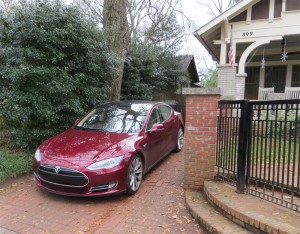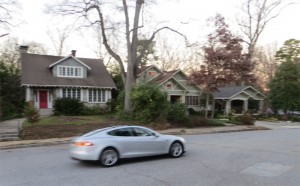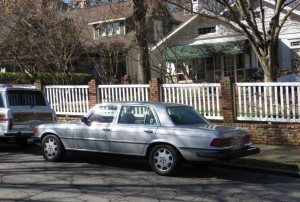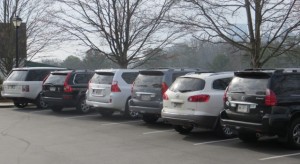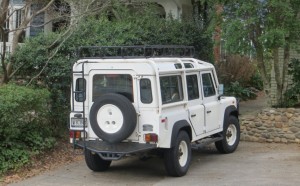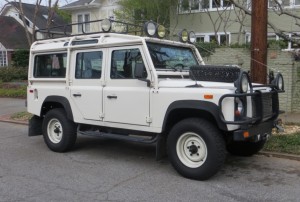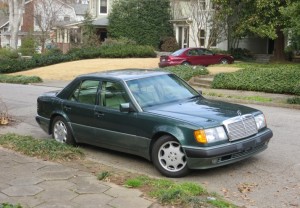Tesla Model S: In The Hood
Posted by Doug DeMuro in In The Hood on | 12 comments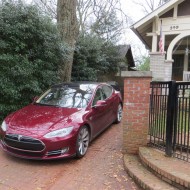
“In the Hood” is my favorite segment here on PlaysWithCars.com, where I will – I swear – one day actually play with cars. Based on the traffic numbers, it’s also your least favorite segment. But since it’s Monday, and it’s been raining since early March, I’ve decided to give myself a treat and post up a few photos from the neighborhood.
I like “In the Hood” because I can put on flip-flops, go outside, and photograph any of the bizarre WASPy cars parked around my neighborhood at any given time. Presumably, you don’t like it because the things I find are always obscure, and typically from the mid-1990s when the Chevrolet Cavalier was actually a competitive compact car.
So I’ve made a compromise: today’s “In the Hood” highlights a car not from the 1990s, but from the future. Behold the Tesla Model S, which has now become so popular in the hood that some neighborhood denizens may soon trade in their E-Class wagons or mid-‘90s Land Cruisers for one.
Just kidding. Those cars have too many European oval stickers on their rear windows to ever let them go.
But the Tesla Model S is pretty popular here, as these photos show. That’s kind of surprising, since this neighborhood would collectively laugh at anyone who showed up driving a Fisker Karma. In fact, they would talk about the Karma owner at neighborhood meetings, saying things like: “Whit bought a Fisker Karma? Oh! That simply isn’t done.”
But apparently, it’s more socially acceptable to buy a Tesla. Is it the styling? The image? The fact that you don’t have to worry about a garage fire? I’m not entirely sure. But I’m convinced it’ll only be a few days before they start sporting European oval stickers.
Mercedes 450SEL 6.9: In The Hood
Posted by Doug DeMuro in In The Hood on | 9 comments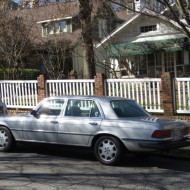
In addition to its usual array of old Land Cruisers and Land Rover Defenders, my old money ‘hood occasionally produces something really cool. This is that.
Shown above (and below, which, admittedly, is odd) is a Mercedes 450SEL 6.9, which debuted in the mid-1970s as a predecessor to virtually every normal sedan with a huge engine offered today. (Think BMW M5.) Actually, that isn’t strictly true: the 450SEL 6.9 was technically the successor to the hot sedan that started everything, the 300SEL 6.3.
But some might argue that the 6.9 is cooler.
To make the 6.9, Mercedes took its typical long-wheelbase S-Class sedan and added a 6.9-liter V8 that made 286hp and 405 pound-feet of torque. US models had less, at 250hp and 360 lb-ft.
These numbers may seem small, but keep in mind that the base-level Corvette of the day had – this is true – 165 horses. Even the Stingray didn’t top 200. By comparison, today’s ‘Vette makes 400 horses. So the same proportional increase (51.5%) would mean an S-Class with 604 hp. Which is exactly how much power the range-topping S65 AMG has. Coincidence? Hmm.
In addition to 6.9’s big motor, Mercedes also added self-leveling hydropneumatic suspension of a similar design to those odd-looking 1960s Citroens. At the time, this was very cool. Now, it makes these cars a pariah on the used market since even minor work costs as much as a C-Class.
But back then, no one cared about the problematic future of the SEL’s suspension – especially Claude Lelouch. Lelouch was a filmmaker who created the famous “C’etait un Rendezvous,” which shows him speeding through Paris in the early morning, running red lights, driving at excess speeds and frequently going the wrong way. His car of choice? A 450SEL 6.9 – though he dubbed a Ferrari’s soundtrack over the Benz’s engine note for the final cut.
Of course, by today’s standards, the SEL 6.9 is positively outdated – even with these later SL-Class wheels added by my neighbor. But it should still hold a special place in the heart of anyone who’s ever lusted after an AMG Mercedes.
In The Hood: Luxury SUVs
Posted by Doug DeMuro in In The Hood on | 5 comments
I’ve come to learn that the mark of a good neighborhood is as follows:
1. Good schools.
2. Friendly neighbors with fluffy dogs named, in almost all cases, Molly.
3. Lemonade stands run by ten-year-old girls who believe that water with a lemon is, in fact, lemonade.
4. Only a small number of homeless people that root through your trash cans at night.
5. A high density of luxury SUVs.
As you can see in the photo, my neighborhood has no problem with number 5, and I promise the number of homeless people that root through my trash cans is reasonably low.
This photo was taken at my neighborhood country club, where luxury SUVs are about as common as disputes settled by a games of lawn bowling. I can’t explain the high concentration of Lexus GX, though it’s clearly an aberration as the most popular vehicle here is by far the Mercedes GL-Class. Both vehicles are wisely purchased by people who didn’t want a minivan, because eww! Gross! A minivan?
I don’t mean to wage war against SUVs here (I drive one, quite happily, because otherwise I wouldn’t be a true denizen of The Hood), but I felt this image was rather a compelling illustration of our motorized society in 2013. Especially In The Hood, where – let’s be honest – they can’t all be driving a Land Rover Defender 110.
In the Hood: NA-Spec Land Rover Defender 110
Posted by Doug DeMuro in In The Hood on | 1 comment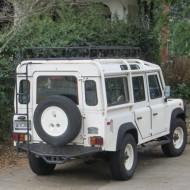
One of life’s unadulterated truisms is the simple reality that you can’t have a wealthy, upper-class, old money neighborhood without having Land Rover Defenders. Typically, these must be driven by wealthy high schoolers who rejected the mere concept of the Jeep Wrangler on the grounds that it’s too plebian. (Actually, a really wealthy neighborhood would have high-schoolers driving droptop G-wagens, but I’m not Rockefeller.)
In The Hood, we have the odd Defender 90 or two. But most importantly, we have two real gems: the North American Spec Defender 110.
While the US Defender lineup consisted of several thousand two-door D-90s coming stateside from 1994 to 1997, we only got the “NA Spec” (later shortened to NAS because apparently these people enjoy acronyms) Defender 110 in 1993. They were all white and all were four-door wagons. Many of them rusted away, while others live happy, fulfilled lives cruising down Milestone Road in Nantucket.
Because of the sheer rarity of the NAS D-110, values have now climbed to absurd levels. A mediocre car (read: a rusty car) brings $40k, while a decent one can command between $60k and $80k. A fully-restored example being sold by a bearded guy in Nantucket might list for $100k or more.
The odd thing about the NAS D-110 is that, with the government’s “25 year” rule now extended to 1988 models, you can import your own D-110 for something like a fifth of the cost of actually buying a NA-Spec car. But the true Land Rover enthusiasts can spot a non-NA-Spec car from a mile away, and if they do, they won’t invite you to Nantucket.
The examples here are numbers 111 and 378, as indicated on the dash plaque proudly displayed near the rear bumper. There’s no plaque to display the owner’s old money status. There doesn’t need to be.
In The Hood: Mercedes 500E
Posted by Doug DeMuro in In The Hood on | 7 comments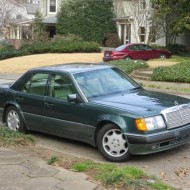
Welcome to a new feature, In The Hood, where I chronicle some of the eclectic cars seen on the streets of the old money neighborhood where I happen to rent a one-bedroom apartment.
This car is the inspiration for In The Hood. Behold, the Mercedes 500E, one of the greatest subtle sedans in the history of time, painted in a color only a German could love. Interestingly, this isn’t the worst color for the 500E. There was also a purple, which occasionally showed up in Mercedes advertisements that convinced people to buy BMWs.
The story on the 500E is this: Porsche was going down. Their product line was down to three embarrassingly dated models: the 944, which had come out a decade earlier; the 928, which actually replaced the chariot in ancient Rome; and the 964, which was purchased by people, apparently.
Headed for failure, Porsche got a break when Stuttgart neighbor Mercedes came by and asked for help building the 500E. It may look like a normal W124 E-Class, but the 500E used a 5.0-liter V8, which was completely unheard of at the time. The period M5, for instance, used a straight-six, while the engine in Audi’s performance model was unknown since it wouldn’t stop unintendly accelerating long enough for anyone to check.
The old story goes that the 500E kept Porsche in business, allowing them to develop the 993 and, eventually, a hatchback whose dimensions roughly resemble the Mayflower.
I had a 500E once. Mine was black. This guy’s is green. I would expect nothing less from the unusual daily car show that is my neighborhood.
